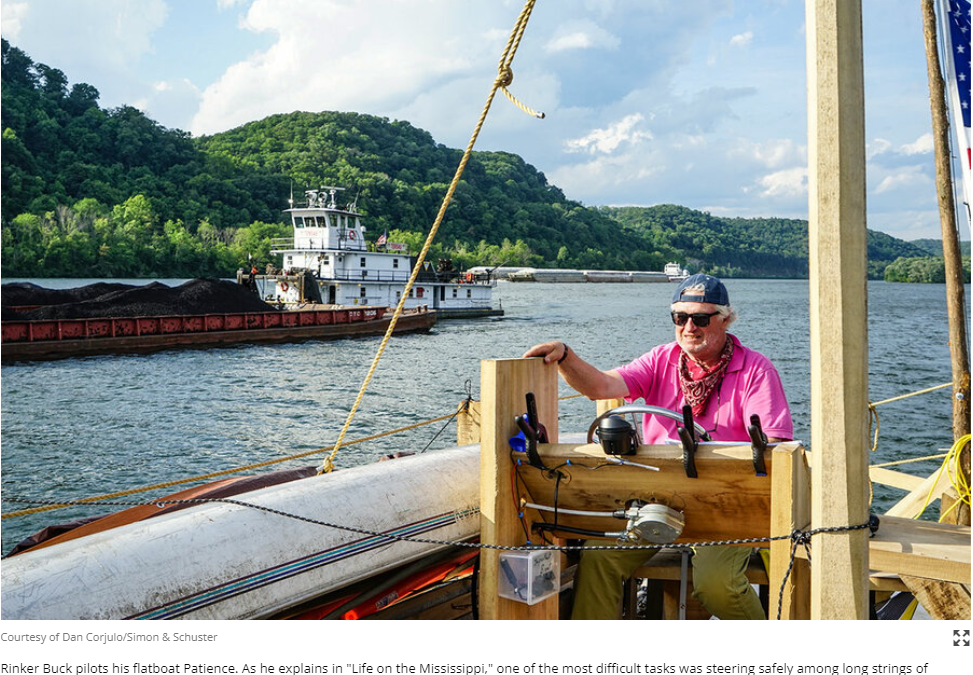In the early years of the 19th century, vast numbers of small wooden boats plied the Ohio and Mississippi Rivers. Carrying goods to market and settlers to the lands beyond the Appalachian Mountains, these vessels launched America’s western expansion. The boats were known by many names but, because they had a flat bottom and a shallow draft, they were commonly called “flatboats.” After the Civil War and the rapid expansion of railroads, they gradually disappeared.
Rinker Buck, a journalist with a deep interest in history and a love of adventure, became fascinated by this little-remembered chapter of American history. He decided that the best way to understand this era would be to build a boat, hire a crew, and travel these legendary rivers himself. He documents the journey in “Life on the Mississippi: An Epic American Adventure.”
He engaged a small, family boatbuilding company in Gallatin, Tennessee, to build the vessel, which was not an exact replica of its forerunners. For starters, it had a motor. It also had modern maps, GPS, a marine radio, a lighted magnetic compass, and an electric bike for getting supplies while docked. He named it Patience and declared, “She was as sturdy as a Roman galleon and looked as jaunty as a … monster truck.”
However, the journey did not start well. He hired a semi-trailer to truck the Patience to the launch site in Pennsylvania but the 550-mile-journey over interstate highways was “an epic fiasco.” The truck suffered a dozen blown-out tires along the way and Buck wondered if he should have named his flatboat Calamity.
Buck was well aware that the trip would be dangerous because the river is more treacherous today than it was 200 years ago. There are locks, dams, sandbars, cement revetments, rock jetties, and mountains of floating debris to avoid. Submerged obstacles like boulders and logs could have easily ripped out the ship’s hull.
More important, thanks to navigational improvements designed to facilitate barge traffic, the river current is much faster today than it used to be. On any given day along the lower Mississippi, there are “at least 820 tugs pushing barges and the typical fifteen-barge string weighs over twenty-two thousand tons, making it virtually impossible for them to alter course quickly,” he writes. And the last 50 miles of the Mississippi River before New Orleans is “essentially a commercial sea-lane, congested with large oceangoing vessels.”
There was no shortage of people telling him that he was nuts. His brothers tried to dissuade him, saying, “You’ll sink the boat in the first storm.” During the trip, with the Patience moored at docks near towns, locals came down to see the boat. They were appalled that the crew wasn’t carrying firearms. Buck writes, “Upriver, the [white] off-duty cops … implored us to get weapons because the Blacks in Vicksburg and Baton Rouge were going to pour over the banks to rob the boat. Downriver, the Black kids were convinced that the rednecks were going to get us. The race-blind solution for all was the same: America, Get Guns.”
Instead, the people the crew met along the way were overwhelmingly welcoming and eager to be helpful. In a time of intense political polarization, it’s uplifting to see so many who were willing to help a modern pilgrim on his journey.
Ultimately, the book is both a travelogue and an engaging history lesson about America’s westward expansion after the Revolutionary War. Of course, the history of antebellum America was also “profoundly tragic.” Buck recounts the central role the Mississippi River played in the Trail of Tears, which saw the expulsion of an estimated 100,000 Native Americans from the Deep South. Later, he writes despairingly of the way flatboats were used to move at least one million enslaved people from the tobacco fields of Virginia to cotton plantations in the Mississippi Valley under horrific conditions. Without river transport, such vast movement of human beings would not have been possible.
After four months and 2,000 miles, Buck navigated the jam-packed Mississippi between Baton Rouge and New Orleans and reached his destination, where he felt “exhaustion, exhaustion, elation, elation.” He also reported being “just maybe more experienced, and a little vain about proving that I could handle a boat.”
Buck points out that he should have discounted the warnings of doom and trusted his own instincts and skills and those of his crew. And he was reminded once again that American history is a story of good and bad, inspiration and shame. He repeatedly talks about the need to look at all sides of the nation’s long and complicated past.
It’s a mark of Buck’s ability to write engagingly of his journey that many readers will conclude that a trip down the Mississippi would be a romantic adventure and a wonderful chance to learn about America’s history. But it’s equally the case that few, if any, of them will want to make the trip by flatboat.
–csmonitor.com






